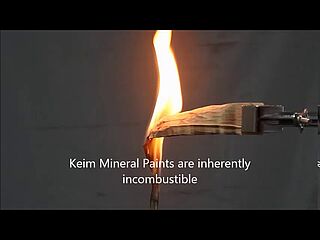Fire Resistance and KEIM Products
Whilst many manufacturers may use mineral pigments within their paints, they don’t all possess the same level of durability, performance, fire resistance and breathability.
KEIM Mineral Paints are water borne, odourless, nontoxic and manufactured with natural ingredients using a low energy manufacturing process. KEIM Mineral Paints contain neither solvents nor any petro-chemical derivatives, are inherently non-combustible, do not support the spread of flame and do not give off any noxious emissions due to their natural inorganic composition
Mineral paints, renders and repair materials are therefore ideal for use in safety critical public areas such as underground stations and tunnels, airports, schools, and in particular high rise buildings.
KEIM interior and exterior paint systems have been tested against the standard EN13501-1, and meet the category A2-s1,d0.
With changes to fire regulations now requiring the use of fire resistant materials on the exterior of residential buildings higher than 11 meters, selection of paints and materials that meet the required criteria is critical.
What are the UK standards around fire resistant paints?
The Euronorm standard EN13501-1 provides the reaction to fire classification procedure for all construction products.
KEIM interior and exterior paint systems have been tested against the standard EN13501-1, and meet the category A2-s1,d0.
A2 relates to how much (if any) a material contributes to the spread of flame, with A2 classified as non-combustible materials.
s1 relates to total during the first ten minutes of exposure. These determine a ‘smoke’ index, with s1 classified as little or no smoke.
d0 relates to ‘flaming droplets and particles’ during the first 10 minutes of exposure, with d0 classified as none (no flaming droplets and particles).
What is the difference between fire resistant and fire retardant paints?
Fire resistant paints are able to withstand fire for a given period of time, creating a barrier against flames to avoid further spreading.
Fire retardant paints, on the other hand, delay the spread of fire by releasing flame-dampening gases when they are exposed to high temperatures.
In short, fire resistant paints protect structures and surfaces from fire damage by creating a barrier against the flames, whereas fire retardant coating are designed to slow down or prevent the spread of flames by releasing a flame dampening gas.
Which KEIM products are fire resistant?
To give customers extra peace of mind, KEIM not only have internal and external paints that are fire resistant, we also have a range of render systems that meet EN 998-1:2010 standards (class A1). Certificates are available upon request.
KEIM paints, renders, and mortars have been tested so that we can categorically claim with confidence which of our products meet A2–s1,d0 or A1.
KEIM paint systems classified as A2–s1,d0 are listed below, these are backed up by fire confirmation certificates against standard EN 13501-1.
Exterior mineral paints: KEIM Granital, KEIM Soldalit, KEIM Soldalit ME, KEIM Concretal W, KEIM Concretal Black.
Colourwashes: KEIM Concretal Lasur.
Interior mineral paints: KEIM Optil, KEIM Ecosil ME, KEIM Innostar.
KEIM Render systems, classified as A1 / A2–s1,d0 are listed below, these are backed up by performance declarations against standard EN 998-1:2010.
Mineral Render system: KEIM Universal Render, KEIM Brillantputz.
Lime Render system: KEIM Kalkputz.
Stone repair system: KEIM Restauro.
How do you apply KEIM fire resistant paints?
The KEIM fire resistant paints can be applied in the traditional method. Please check each paint system for the application recommended which include spray painting, roller, and brush.
What should I look for when specifying fire resistant paint and render systems?
We would always recommend checking the details of products to ensure their suitability for your chosen application. Scrutinise the technical or data sheet and any declarations or certificates which should be made available to view.
If in doubt, please ask the question.

